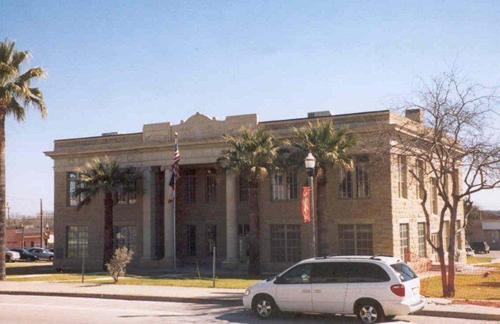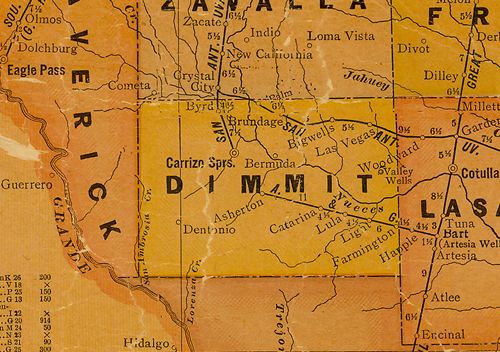Carrizo Springs, Texas, Dimmit County Seat (original) (raw)

Carrizo Springs 1940s Street scene
Postcard courtesy www.rootsweb.com/ %7Etxpstcrd/
History in a Pecan Shell
The names: Phillip Dimitt had received the original grant of land as a naturalized Mexican citizen. He became the honoree for the county name - although the legislature misspelled Dimitt. People have grown fond of the misspelling over the years and so it has been kept.
Carrizo is Spanish for reeds.
Carrizo Springs is the oldest town in Dimmit County. The name comes from the local springs (and the reeds) and the settlement began around 1865. Families from Atascosa County moved into the area that year and they were joined the following year with a group from Goliad.
Dimmit County was organized in 1880 and Carrizo Springs was designated the county seat.
In 1880 early settler Levi English donated land for the town including schools, churches, and a courthouse.
In 1884 the Dimmit County courthouse was finished and the Carrizo Springs Javelin was first published.
The population was a healthy 500 persons in 1885.
In 1900 artesian water was used to irrigate crops and new settlers arrived. In 1904 thirty wells were irrigating 1,000 acres of cropland.
In 1910 the town incorporated when the San Antonio, Uvalde and Gulf Railroad came to town.
The town had 1,200 people by 1915, and the town was electrified the next year. The 20s began with a drought, but later in the decade they caught up with the rest of the nation's prosperity. Streets were paved and the courthouse was remodeled.
By 1928 the population had reached 2,500.
Carrizo Springs' growth kept it the dominant city in Dimmit County and it had the only newspaper and only radio station in the county in 1984.
In 1988 the population was 7,553.
Carrizo Springs, Texas Landmarks
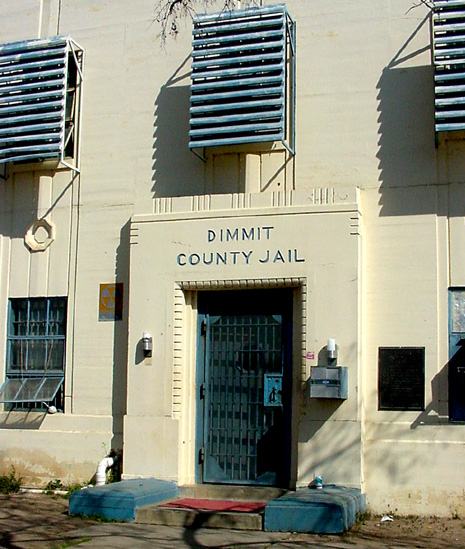
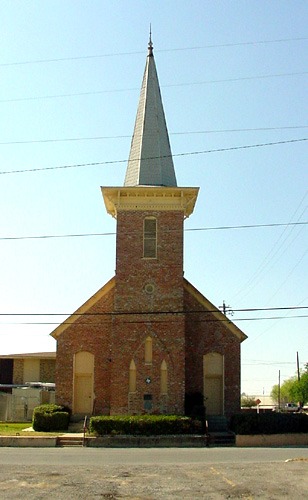
Carrizo Springs First Baptist Church
Recorded Texas Historic Landmark
706 Houston St.
28� 31' 22.74" N, 99� 51' 43.49" W
TE photo, 2002
Historical Marker:
First Baptist Church
First church built by Texas Baptists west of Nueces River. Organized May 27, 1878. Building constructed 1888-1891 on land donated by Levi and Matilda English. Designed by pastor, Rev. R. H. Brown. Congregation and other citizens furnished labor to burn brick and lime, haul the lumber from Cotulla, and put up the building. Of the seven charter members, two were former Methodists and one man was an ex-slave.
Recorded Texas Historic Landmark, 1966


South Texas architecture in Carrizo Springs
TE photo, 2002
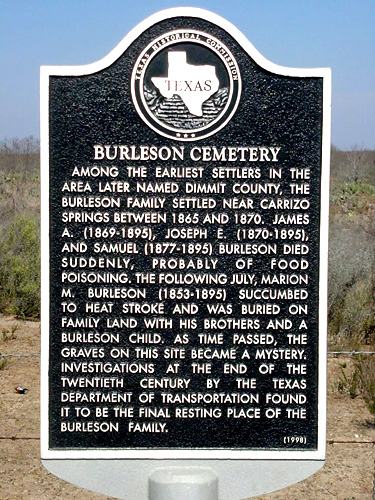
Burleson Cemetery
4 miles NW of Carrizo Springs on US 277
TE photo, 2002
Historical Marker:
Burleson Cemetery
Among the earliest settlers in the area later named Dimmit County, the Burleson family settled near Carrizo Springs between 1865 and 1870. James A. (1869-1895), Joseph E. (1870-1895), and Samuel (1877-1895) Burleson died suddenly, probably of food poisoning. The following July, Marion M. Burleson (1853-1895) succumbed to heat stroke and was buried on family land with his brothers and a Burleson child. As time passed, the graves on this site became a mystery. Investigations at the end of the twentieth century by the Texas Department of Transportation found it to be the final resting place of the Burleson family.
(1998)
More Texas Cemeteries
1936 Texas Centennial Marker (FM 1433 at Dam at south end of lake):
Espantosa Lake
Most famous camping ground on Presidio Road. Earliest route between Texas and Coahuila. Many legends center about the lake. Here in 1876 Texas Rangers killed a band of desperadoes.
1936)
More Texas Lakes
Carrizo Springs Chronicles
- The Vidalia Onion
"Toombs County, Georgia is acknowledged to be the birthplace of the Vidallia Onion. Georgia had been having a problem with weeds that were growing faster than the locally planted onion sets. Texas transplants, it was hoped, would give the farmers a much-needed head start and so Texas Granex onions from Carrizo Springs were shipped there in 1952. ..." more - Henigan Water by Mike Cox ("Texas Tales"column)
"...Word of the amazing restorative qualities of the water spread faster than the contents of a spilled bucket. The Javelin said the people of Carrizo Springs got so healthy that the local doctors practically fell into poverty...." - South Texas Justice by Dianne West Short
Dimmit County Chamber of Commerce
310 West Nopal / P. O. Box 699
Carrizo Springs, TX 78834-6699
(830) 876-5205
http://www.dimmitcountytx.com/
Texas Escapes, in its purpose to preserve historic, endangered and vanishing Texas, asks that anyone wishing to share their local history, stories, landmarks and recent or vintage photos, please contact us.
